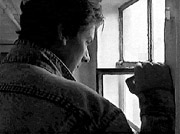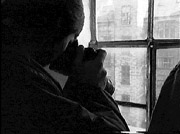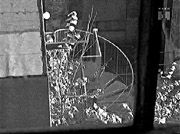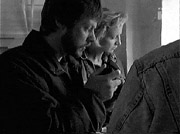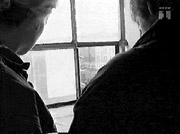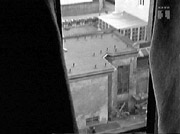IntroductionWhen the new students in Media Studies arrive in September, I give them small bits of audio-visual productions (ads, fiction, documentaries, etc.) with no sound and no subtitles. The students are then invited to determine which type of text they see on the screen. They are hardly ever mistaken. Small bits of stories (usually less than 60 seconds) are sufficient, even if I do my best to find ambiguous examples. There are probably many reasons for these marvelous analytical skills. The students base their judgment on a wide range of criteria: the lighting, the actions of the protagonists - and the camera movement is probably one of the main reasons why they rarely make mistakes about the status of the text: fiction or fact?
This year (September 1997) the students had to make statements about extracts
from "Den store aktion" (The Great Action)(DSA).
Nor does the spectator get the main information in the beginning. Information is distributed (withheld) the same way as in a movie, with no voice over pointing out what is important and what is less important. The lesson or moral is never explained. The viewer must find it himself. Lars Engels's documentaries are organized more according to time than to relevance (as in newspaper articles). His stories therefore look more like narratives than information.
Does this particular status of Lars Engels's programs ("non-fictional
narrative") have any importance for the use of camera movements? Are the camera
movements in these programs different from those used in fiction and in Danish
mainstream television documentaries? Do possible differences in camera
movements have any importance for the length and function of the shots or for
the whole editing process?
In terms of deixis, we are in a diegetic universe: we, now, here all refer to entities in the story, never to the here, now and me of the viewer.
The result of all this is that the camera work becomes more important than in
normal documentaries - and even more important than in most fiction, since the
cinematographer's work must compensate for the lack of detailed planning (of
shots, editing, etc.) that is specific to the production of fiction.
Normally Lars Engels uses only one camera - the presence of two or more cameras would disturb the situations filmed. Camera movements can never be planned and the editing can never involve a choice between two versions of the same action or event. This distinguishes Lars Engels's production not only from the fiction film, but also from most factual programs on television where editing in real time is common (just think of the incredible number of cameras that cover a football match, not to mention Diana's funeral).
DSA is an "extreme" case: one camera has to provide material for a very
straight narrative made up of many small actions with varying descriptions of
persons and environments, and without the aid of a voice over to fill in gaps
in the story.
After viewing each scene, the students indicated whether they thought it was factual or fiction, as well as the criteria on which they based this judgment; they were also asked to characterize the camerawork. This procedure is, of course, far from a genuine reception analysis, and only one of many ways to obtain statements about a very particular problem. We cannot claim statistical significance as there were only 32 students answering these questions. An analysis of their replies provided little new information. However, what the answers did give us is a range of possible perceptions of and attitudes toward the camera movement in the story. It is rather strange that the number of students who thought they were looking at a piece of fiction, varies from scene to scene. Scene 1: Some students think we see a "hidden camera". We are the invisible observer, the camera is our eye. The camera is not stable, it is handheld and it is seeking something, it pursues something. This explains the many zooms and close-ups. The investigating camera is typical for documentary. The students add that the shots are very long. They even find the camera rather unprofessional; the movements do not seem to be part of a deliberate strategy. Scene 2: Six students think this could be fiction, but basically give the same comments as before, commenting on the use of a hidden camera, the long zooms, the handheld camera, the investigating camera that catches whatever is there. Some wonder whether the camera is unable to distinguish between important and unimportant. And some students mention that the camera looks over the shoulder of the policemen, down at the scene outside. They do not agree about the action. Some say that there is too little action and others that there is too much! One says there is too little tension. We may interpret these very divergent answers in the following way: the action going on in the backyard is very coherent at the picture plane (remember that there was no sound); the action is also very complex. Some students therefore believe this is fiction (the impossibility of getting complicated actions in the real world). They mention that the scene is realistic, as in a documentary; it is as if we were there. This is a fiction dressed in the clothes of the documentary, with the camera chasing the protagonists. Scene 3: The students' answers do not add much to what appeared in their replies about the preceding scenes (few cuts, general use of pans, the camera following the protagonists and trying to catch sudden movements). Some students stress the fact that there is a kind of community or common point of view between the police and the camera. This implies or should imply that the camera (represents a person who) has the same status as the policemen. If this is true, it should have consequences for the ways in which we identify with the protagonists. The conferences No student seriously attempts to see these scenes as fiction. The camera movement is too unstructured, too unstrategic; the camera follows the protagonists and does so very slowly, too slowly to be fiction. Conversely there are very few cuts.
The camera guides us. It describes, it does not tell a story; we are hidden
observers looking at a piece of reality. The absence of narration is partly due
to the fact that the sound has been cut off. The action in these scenes
consists in the preparation of the great police action. What the students have
seen is a scene with people talking, listening and looking at a sketch.
I have chosen three pieces of fiction (film and television) in order to compare the camera movement in these productions with the camera movement in DSA: Riget (The Kingdom) because of the famous use of handheld camera in this serial and Tavernier's "L627" because stylistically and thematically it has certain similarities to DSA. Tavernier uses a documentary style to tell a story about a group of police(wo)men and their daily fight against drug crime. Finally I have had a brief look at "NYPD Blue" for the same reasons. As for television documentaries, I have looked at some of the last years' Danish productions that have either a thematic, a stylistic or a structural similarity to DSA. The camera in "Riget" The movement in the first scene (with two persons) in "The Kingdom" is remarkable in its degree of planning and unambiguity. Otto Brandenburg, the night watchman, has just been at the front door to have a look at a mysterious ambulance. The camera is placed in the corridor looking towards the door. Brandenburg walks directly toward us, then moves slightly to the left, with the camera following him (he remains in the left half of the screen). When the camera has panned almost 180 degrees and looks in the opposite direction, Krogshøj comes in from the left background, and the two men have a brief discussion, with Krogshøj standing to the left and Brandenburg to the right at some distance from the camera. Then the camera moves towards the two persons and turns round (180 degrees) behind the back of Krogshøj. The movement stops when Krogshøj is to the right and Brandenburg to the left. Then Krogshøj leaves (to the right) Brandenburg, who looks in the direction of the front door. The camera movement is smooth; there are no cuts; but it is a complex movement with two ways of turning 180 degrees. But the camera is not spectacular. The viewer is not attentive to the camera. Its movements are "pure" or transparent. We see the persons and their movements; the camera movements are motivated within the framework of the actions or the plot. Within one single movement (cut), the camera constructs a whole narrative passage with a beginning, a middle and an end; it even returns us to the point of departure. The camera in "The Kingdom" is said to be experimental. This may be true (I think it is), but in this case the camera gives us a classical and transparent story movement and prepares the next scene (Brandenburg and his dog). We are not able to distinguish between action and camera: to us they are both integral parts of this scene. "Helmer's arrival". The scene in which Helmer appears for the first time in the film uses a cut-on-movement, which is one of the famous experiments used in the film. First we see Helmer going to the right. Then he stumbles. Cut. We then see him still stumbling, but now going to the left. The camera angle has turned 180 degrees. This jump is totally unjustified, the spectator gets a kind of shock. But s/he does not ask: "Why the change in camera angle?", but simply: "What happens?" or "What's going on?". All the mad camera work is seen as the expression of the action and the mood of the protagonist - Helmer is furious. We do not distinguish camera and action, we perceive a totality. Be it the classical movement from the opening scene or the "jump cut on movement" in "Helmer's arrival." The camera in "L 627" Tavernier's film about a police station is in many respects based on the aesthetics of the documentary and the indexical truth of documentary pictures. The lighting gives you the impression that the film maker has used the light that was available on location. We see everything from the point of view of the police. The opponents (the criminals) are all seen from the outside, the only exception being the prostitute Cécile - exactly the same distribution as we find in DSA, portraying the police(wo)men + three narco prostitutes whose background, beliefs and hopes we know a bit about. The camera in "L 627" often looks handheld. The movements are not remarkable, but performed in function of the actions in the scene (no trace of the "jump cut in movement"). When the camera shows the life at the police station, it is usually immobile: no or few zooms or pans, occasionally a travelling. But there are frequent cuts, some of which are cuts on movement. In one of the "lunch scenes," there are rather many cuts, one zoom on the face of a controversial person, and a travelling when we follow a person going from one position to another. But the camera is in perpetual movement in the great action sequence in the metro. There, the camera hunts the persons that are on the verge of getting out of sight. All of this is clearly based on the camera movement of the factual reportage . In the observation scenes of "L627," all that is seen in the street is chaos, but the camera remains stable with some use of zooms. The camera is not at all used in DSA where there is a great deal of movement.
"NYPD Blue" uses a camera that sometimes looks handheld, but the complex
combinations of camera movements, of the protagonists' movements and the cuts
make any mistake impossible.
Camera movement in "113 skud" In "113 skud" (113 shots) the camera is normally immobile, with some zoom ins and outs. There are some pans, especially when the camera (one camera) has to follow two actions going on at two (not too distant) locations. During the great battle scenes in this program, the camera captures the demonstrators rushing toward us. When the demonstrators have come close to us, the camera pans and the demonstrators now continue to the left, and finally the camera captures the demonstrators from behind. The important thing is that the camera follows the events. The events set the agenda. The handheld camera sometimes provides a blurred picture and sometimes it fills at an odd angle. All this is understood as the impact of the events, as an indexical truth and not as a stylistic effort. "På ministerens vegne" (On behalf of the minister) The theme of this documentary has some features in common with "113 shots," especially in the scenes where the battle of Nørrebro is shown. But as these pictures mostly function as reminders and do not have a documentary or descriptive function, there are many more cuts (= short shots). The structure of the program is like a presentation of facts and hypotheses made by J.O. Jersild. And when he is there, camera movements are reduced to some zooms and pans on Jersild and on what he shows us. The movements are slow and planned because the stage and the presentation are planned. Every effort is made to keep the movements as unnoticeable as possible, but even this reduced camera movement is (probably) felt as distinct from what is going on. "Ren mafia" (Mob only) As in "On behalf of the minister", the anchorman and his voice are the only vehicles of coherence of the program. The importance of interviews is greater. There are no action scenes (except for one at the end of the program), but rather some rare scenes with people walking in the street The need for camera movement is therefore minimal. The program was famous because of its use of a hidden camera - a camera presented thoroughly to the viewers. It was established in the minds of the viewers as different or distinct from the actions going on. "Guds udvalgte" (God's Chosen) As in DSA, this reportage employs no voice over. All interview questions are cut out. It creates the illusion of a pure registration of reality. The camera is used in very divergent ways. In the interviews with witnesses (which have the form of monologues for one or two persons), the camera is totally immobilized and the people interviewed are sitting motionlessly, making no gestures. In the interviews with the priest, the camera makes some moves and uses some zooms. In the preaching scenes (in the street or in the church), the camera follows the priest and there is a general use of cuts: people listening during the priest's sermon alternate with the priest. The audience forms a visual comment to the speech. This way of presenting things is not always possible in DSA. It also implies that "Guds børn" requires the camera to follow the protagonists. "Guds børn" may therefore use more cutting.
As a conclusion, the three pieces of fiction show us camera movement and a
general use of the camera (related to the use of cuts) which does not invite us
as spectators or viewers to distinguish between the camera and what the camera
shows. We do not distinguish content from camera. The four documentaries show a
quite different use of the camera: either the camera is immobile or it pursues
the action. In either case, we are aware that the camera is one thing and the
content something different.
In all these cases (and we could have chosen other types of scenes as well), we look at situations or actions that are frequent in television fiction and even in film, segments in the definition of John Ellis. Observation scenes: Normally these scenes begin with a kind of establishing shot, an immobile camera showing the protagonists looking out of the window. The camera then has a limited number of possible movements: it can zoom in on the observers (to capture the visual expression of their feelings), or it can pan to another person in the room. The camera can at first be placed at some distance from the persons. It then has the possibility of moving round the back of the observers and of passing between them in a "strong" movement: the camera becomes the third (or the fourth observer), looking down at the street or the backyard. Then we see what the policemen are observing. The camera may make a moderate zoom, but everything is nevertheless seen at a distance. In some cases there is a cut and what we see in the street should then be considered as a pov shot. Sometimes there is a continuing movement and we should then consider the camera as the third/fourth observer. To Lars Schou, the photographer of DSA, we have a pov camera in both cases. In the case of the continuous movement with no cut, he refers to a converted pov camera. Most of the literature supports his interpretation on this matter. We see a person looking intently through the window; the camera is looking through the window at something. The camera looks at something in the same way a person would. But I am not convinced that things are that easy at the reception level. For three reasons, I believe we still think of the camera as something distinct from what is going on. Firstly, the very remarkable movement round and between the policemen establishes a position distinct from that of the policemen. Even in the scenes where the cut should indicate a true pov camera. Secondly, we look at the situation/actions in the street or in the backyard and one of the policemen comments what is going on and/or directs the actions. This too makes a clear distinction between the observing camera and the active policemen. Thirdly, the actions going on in the street or in the backyard are clearly documentary. When the camera shows these scenes, it can only follow the protagonists by means of pans and eventually tilts. It is as if the camera does this on the directions of the policemen who make comments or orders as to what is going on. The camera tries to prevent the persons from running out of sight. The viewer will normally interpret this as the camera's struggle with reality, the indexical truth. This leaves no room for the perception of a pov camera. The more we perceive an indexical camera, the less we can interpret the scene as a pov camera . The conferences The camera also makes a kind of establishing shot of the main character of the scene, possibly with a zoom. Then the camera pans, following the persons who are speaking, or in some cases, the persons listening to the chief inspector. The camera remains at the same place. There is very little travelling. This fixed camera position, the use of pans and very little cutting is typical of these scenes. The spoken text of these scenes often forms a continuum (the chief inspectors planning of the action). It is very difficult to leave out details. If you want to cut in this continuum in order to show people listening, you have to use pictures showing people listening to something else. In this way, the one and only camera is forced to provide very long shots with pans and zooms. and it becomes rather difficult to present these scenes as a story. (As we have seen, the students were in some cases irritated by the meetings.) However, the information transmitted in these scenes is indispensable for the overall story. Lars Schou succeeds in avoiding the catastrophe by means of smooth camera movement and by showing expressive faces. The staircase The camera moves very quickly. It runs on the stairs, it pans, tilts up and down the staircase, ending with a bird's eye or a frog's eye view. The zooms at persons sometimes end as extreme close ups. The beginning of the scene is marked by all these movements. The classical handheld camera in action is now easily felt as fictional - the fiction imitating the documentary. Then the movement almost stops. We see the policemen talking with the prostitutes about their economic situation. The sudden change from the dramatic action to immobilized reality is achieved by the camera, but also by a very marked use of cuts. This scene then appears much more narrative than the meetings at the police station. It should be added that the light in the staircase is another factor. The clair obscure is a marvelous story teller too. The light in the police station is not good for story telling! Police car in the streets
These scenes are used to mark breaks in the action and to take us from one
place to another. As the camera is inside the car, the only possible movements
are zooms and in some cases pans. The production conditions limit the
possibilities of the camera: we look through the front window or through the
window of the driver.
When a film like "L627" or a serial like "NYPD Blue" uses a camera that looks
handheld, we have a stylistic device, a loan from the documentary, now used as
a metaphor for reality. The thoroughly planned combinations of camera movements
and the movements of the protagonists in fiction, are what distinguishes
fiction from fact in the perception of the viewer.
What really matters (and this appears from all that precedes) is that "when you have to describe reality nothing is given beforehand. Everything is unpredictable and things only happen once. In principle, you have only one "take". This is what I feel as a challenge". But this reality offers "unforeseen possibilities in presentation, visual language, moods, metaphors, light, etc." (Lars Schou in "Skidt og Kanal", 1996, 8). This is the way Lars Schou worked in DSA. Only one camera was used. Almost nothing could be prepared. There is one brief reconstructed shot; one scene was postponed in order to be photographed and some of the scenes (the conferences) were scheduled beforehand, but the rest was unpredictable. To make a coherent story, the program has to rely on editing (cutting), but as we have seen, this is not always possible. That is why the photographer has to say "now I am here": he/she has to realize that things are happening now. He knows the location and people present (in the case of Lars Engels's programs). The photographer must look around, on both sides, and not only straight ahead to find out what is going on. It is a question of feeling things coming in order to move the camera in that direction; it is a way of "direct editing with the camera" (interview with Lars Schou, 19 September 1997). Lars Schou prefers shots lasting as long as possible.
The important thing is that during the camerawork, Lars Schou knows what is
going on outside the camera, but the viewer will never know anything but what
the camera sees. This is what the photographer must have in mind in order to
capture the essentials of the situation. That is why he uses the movement of
the camera behind and between the observer. In that way the viewers are present
either as a pov camera or as what Lars Schou calls a converted pov.
(Conversation with Lars Schou, 19 September 1997.)
But we notice and are sensitive to the deviant sentence or shot even if we cannot explain what is wrong (or for that matter, right). As in language: the structures of Danish are known only by the experts. We are usually unconscious of the structures. This is what happens in film. We have built up an enormous knowledge of filmic language based on everyday experience and on all the audiovisual products we have seen. Our comprehension of the complex combination of the protagonists' movements and camera movements form a chapter of the audiovisual grammar and this reception grammar cannot be reduced to a mere transfer of our everyday perceptions to film. The students were not prepared for this joke. But they already had an extensive knowledge of film and to a certain extent, they were able to explain how they could decide whether or not the scenes were factual. They were able to reconstruct the grammar. We all have some prototypical models for the understanding of audiovisual products. In the case of the distinction between fact and fiction, the prototypical models are amazingly strong.
|
